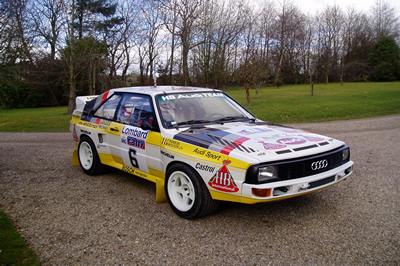Background
The Quattro rally car was homologated as a Group 4 challenger on the 1st January 1981 and unfortunately its debut in the World Rally Championship was a mixed affair, with both cars retiring. Although at the point of his retirement Hannu Mikkola had a lead of over six minutes, demonstrating that it was only a matter of time before the wins would come.
Highlights of Audi’s 1981 season were Michelle Mouton’s win on the San Remo Rally, which secured her place in the record books as the first woman to win a round of the World Rally Championship, followed by the utter dominance of Hannu Mikkola on the RAC rally, when he brought home the Quattro 21 minutes ahead of the 1981 World Champion Ari Vatanen’s Ford Escort.
The Audi Quattro collected 7 wins during 1982 season, before being modify to compete under the Group B rules that were to be introduced in 1983.
The first incarnation of Audi’s Group B charge was launched in January 1983 and was a relatively lightly modified version of the Group 4 car. The most notable change was the metal being used in the construction of the cylinder block which was now manufactured from Aluminium rather than Iron and led to the car being known as the A1.
The A2 followed shortly afterwards and saw the engine capacity reduced from 2,144 cc to 2,109cc, which meant that the Quattro could compete in the up to 3 ltr class (after the turbo factoring was taken into account) and so benefit from a reduction of 140kgs in minimum car weight.
By mid 1984, the Quattro’s size meant that it was becoming an also ran against its smaller peers, and this led Audi creating the Audi Sport Quattro or as it is more commonly known the S1. The S1’s body shell underwent a number of alterations to improve handling, some subtle, like the relocation of the oil cooler to the boot, some less so, the reduction in length by 320mm, whilst the use of Carbon Kevlar panels helped save excess weight.
The S1 lasted for a single season before Audi introduced a further upgrade in the form of the Audi S1 E2, which saw a further increase in power and amongst other technological advances a central differential allowing the torque to be split unequally between the front to rear and an early form of anti-lag system. The bodywork underwent further alterations resulting in the iconic aggressive aerodynamic kit consisting of front and rear wings.
This Car
Is chassis number RS02, which debuted in 1984 on the 1000 Lakes Rally in the hands of Hannu Mikkola, who unfortunately retired on the third leg of the event after suffering a second broken steering arm.
Audi did not fare much better with RS02 on the 1984 Rallye San Remo, as Stig Blomqvist retired with engine failure after an oil pipe burst and Walter Röhrl aquaplaned off the road on the last night destroying his S1 whilst hunting down the leading Peugeot 205 T16 of Ari Vatanen.
Michèle Mouton took RS02 into the RAC Rally in the hope of securing a finish and the 1984 Manufacturer’s championship for Audi. Mouton was second for some time in the early stages and ran third for most of the event, eventually finishing fourth behind Vatanen (Peugeot T16), Mikkola (Audi Quattro A2) and Eklund (Audi Quattro A2). The result was good enough to secure Audi the Manufacturer’s Championship. Audi’s also took the top two positions in the World Driver’s Championship with Stig Blomqvist taking the overall title, and Hannu Mikkola (the 1983 champion) runner up.
RS02 was subsequently sold to Jean Krucker, who used it in the 1986 European Rally Championship, which proved to be its last year of competition.
Only a very few genuine original works S1s exist, RS02 is quite unique as it has the distinction of having been driven by two World Champions and arguably the most successful ladies driver of all time, Michèle Mouton. This is unique as other works S1s seem to have spent their competition life in the hands of one works driver. Several years ago, Dermott Simpson (its current owner) bought RS02 and subsequently had it restored, by an Audi Sport technician of the period, to its present condition. The car is absolutely original in every respect and has been restored to the specification that it would have finished the 1984 RAC.
Technical :-
Engine : Five cylinder, in-line, longitudinally mounted front-engine, twin overhead camshafts, four valves per cylinder, 510 bhp, 2,110
Induction : KKK Turbo charger wih Bosch fuel injectionBody : spaceframe steel chassis with glassfibre & Kevlar bodyworkTransmission : Four Wheel Drive, six speed gearboxWeight : 1090 kg

